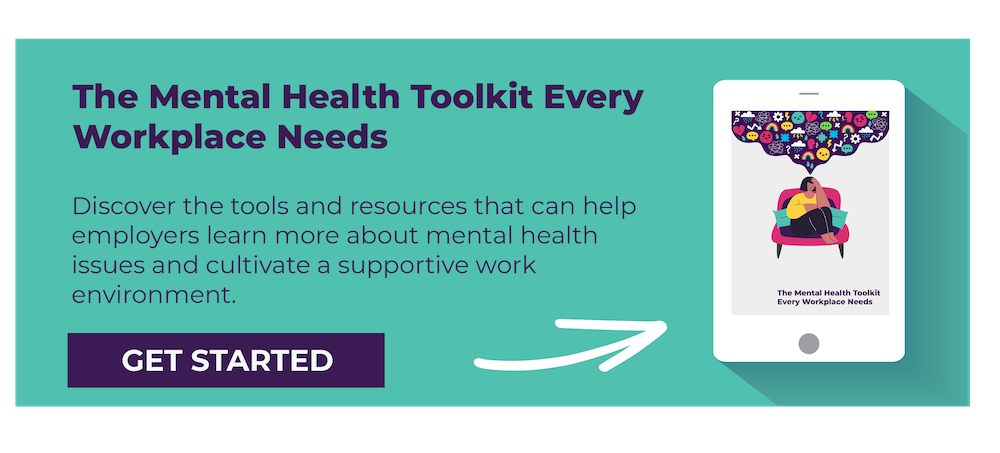 These days, it’s nearly impossible to talk about corporate wellness without a discussion on mental health and the workplace.
These days, it’s nearly impossible to talk about corporate wellness without a discussion on mental health and the workplace.
With nearly half of mentally ill adults not receiving treatment — that’s over 27 million Americans — mental health prioritization at work is essential for companies wishing for healthier workers.
Given that mental health issues can cause prolonged absenteeism in the workplace, it’s a wise move for employers — and employees — to take interest in ways to improve mental health at work. Whether it’s depression, anxiety, or another mental illness, offering workplace support to help individuals with those conditions can improve productivity and decrease medical costs.
This post will share the ROI of mental health support, along with ways to keep mental health support resources front and center in a more relaxed post-pandemic world.
Where Mental Health and the Workplace Intersect
The workplace is where most of your employees spend their time when they aren’t at home. Since most people have to work to make a living, it makes sense that many workplaces are a “second home” or a place where individuals find value, purpose, meaning, and joy.
In that same vein, like a home, workplaces must be healthy places — physically and emotionally — for individuals to thrive. With the pandemic putting a huge spotlight on mental well-being over the last few years, it’s essential for companies to consider how they are helping and not harming workers’ mental health.
Offering help not only benefits the individual but also the company they serve. Otherwise, it can end up being a costly emotional and financial road to both employer and employee.Related: 21 Mental Health Awareness Month Activities for the Workplace
For example, employees with unresolved depression experience a 35% reduction in productivity, according to the American Psychiatric Association. That contributes to the loss of around $210.5 billion a year in absenteeism, reduced productivity, and associated medical costs.
The Mental Health – A Workforce Crisis, a report from the American Heart Association CEO Roundtable and Center for Workplace Health Research and Evaluation found a strong link between physical and mental health. The report urges companies to consider how to incorporate comprehensive programs focused on mental illness prevention as well as treatment.
The report states, “Like chronic diseases, mental health disorders are treatable, and employers can use comprehensive strategies to cultivate supportive work environments.”
For the companies that do offer such programs and environments, the results of better mental health are clear as seen from the studies and reports below.
The ROI of Investing in Your Employees’ Mental Well-Being
In the business world these days, it’s often expected that employees will be taken care of when it comes to mental health needs. While additional days off or four-day work weeks are nice, sustainable practices and mentally healthy workplaces are what need to be at the top of the list.
Investing in mental health offers opportunities for return on investment for individuals, families, and communities as individuals get or stay mentally well. As 2022 starts to unfold, keeping mental health as a pillar of wellness programs and campaigns will provide anchors for developing a mentally sound workplace.
Here are a few reasons to keep mental health front and center in the workplace:
- Boosts productivity - If your team members get the help they need, they can thrive. One study found nearly 86% of employees treated for depression reported improved work performance.
- Decreases health care and disability costs - Those with serious mental illness have an increased risk of health issues like diabetes, according to the National Alliance on Mental Illness. Reduce that risk by offering more mental health support.
- Improves communication - If your team members are feeling mentally healthy, they can better communicate their needs and appropriately respond to fellow colleagues.
- Improves retention - A 2019 survey showed that half of millennials and 75% of Gen-Zers left a job — both voluntarily and involuntarily — partially because of mental health issues.
Depending on the demographics of your workplace, your workers may also be suffering even more than they were before the pandemic. One out of five Millennials and Gen Z individuals reports feeling “a lot more stressed and anxious” than before the pandemic, according to the 2021 Millennials and Generation Z — Making Mental Health at Work a Priority report. Of those individuals, six in 10 say they didn’t let a workplace supervisor know how they were feeling.
How to Keep Mental Health Resources Alive in the Workplace
As we start to look at the pandemic more in the rearview mirror, it’s important to keep in mind that the anxiety many are feeling probably won’t be left behind as easily. Put the stigma of mental illness to rest and allow programs and a supportive culture to flourish.
Here’s how:
Awareness
A third of employees surveyed by the American Psychiatric Association said they worry about the consequences of needing mental health help. By creating awareness and empathy around mental health at work, it reduces the feelings of shame workers may have around reaching out for help.
Employers understand at this point that both workplace and life situations contribute to mental health. The impact on employees can be significant, especially for those without any sort of support. Simply having awareness — and then taking action — in the workplace is enough to shed light on the fact that mental health doesn’t need to be taboo in the workplace. Create awareness among management and start conversations with your team members, too.
Promote Life Management Resources Often
Life is full of challenges. For many people, facing those challenges without any sort of support can be overwhelming and downright painful. They don’t have the tools or means to face an onslaught of stressful situations. That’s when mental health issues can really arise or worsen.
Helpful resources:
- Provide mental health counseling
- Give workers access to free self-assessment tools
- Offer medications with no or low out-of-pocket costs
- Explore the use of depression screenings and follow up
As an employer, do your best to promote life management resources often. In doing so, you empower your employees to take charge of their actions and improve their lifestyles.
Related: 5 Telltale Signs You Need to Take a Mental Health Day From Work
Provide Essential Time Off
Staying healthy requires a certain amount of dedication and time to maintain optimal health. For your employees, this goes well beyond just eating well and exercising. It also means keeping up with regular doctor’s appointments, specialty appointments, doing blood work, and more. For those with chronic illnesses like diabetes or fibromyalgia, for example, those appointments are even more important to keep. Give your employees time off — preferably paid — to take care of the appointments they need to stay well.
Offer Meaningful Connections
Given that many of us spend numerous hours of our lives at work, it’s important to remember that creating an enjoyable work atmosphere can make all the difference. This is especially important for keeping workers from feeling bored, stressed, and overwhelmed — all factors that were intensified during the pandemic. In-between the daily work duties, find ways to connect with your workers.
A few ways to offer meaningful connections:
- Build trust - Sure, you can do trust falls or group team-building activities, but creating an open culture with open communication helps, too. Make it a common workplace occurrence to have conversations that extend beyond, “What did you do this weekend?”
- Grow together - It’s true that when you’re with like-minded individuals with common goals and interests, you mesh better together. Take the time to have your team review their personal and professional goals together. Go on a retreat as a team or attend a seminar for personal growth and development — regroup to discuss and talk personal goals.
- Keep workaholics in check - When you see team members working too much, check-in with them. It may be an avoidance technique (things are rough at home, they’re dealing with personal issues they don’t want to face, etc.) and can lead to overwhelm and burnout.
The feeling of being connected and supported in the workplace is one that can’t be replaced by other tangible benefits or perks. Take the time to connect with your team members and have other leaders do the same. The payoff is bound to be a healthier and more cohesive team that has each other’s backs.
Pay For Useful Calming Tools
There are tons of free and premium apps that can help your team with mental well-being. Everything from meditation apps to talk therapy apps and everything in-between. Invest in the resources and gather feedback from your team after a calendar quarter of usage to see how they are benefitting from the apps. Adjust plans as needed and work with your team members to see what type of support they need and if it’s available in app form.
It’s Time for a Mental Health Check at Your Workplace
If your company hasn’t made the move yet, it’s time for a mental health check-in at your workplace today. This isn’t a once-a-year or quarterly task, either. Mental well-being is a daily factor everyone has to balance, which means companies must play a role in that delicate balance.
When leadership makes mental health a priority, it creates a more resilient workplace. Employees will no doubt sleep better, feel better, and work better when they know their company has their emotional and physical health in mind.
Here’s to better mental health in your workplace!
What have you found to be useful for improving mental health in your workplace? Share your thoughts in the comments below!



